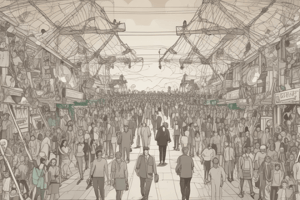Podcast
Questions and Answers
What is a social group?
What is a social group?
A collection of individuals who interact with each other and share a common identity, purpose, or goal.
What is the main difference between formal and informal groups?
What is the main difference between formal and informal groups?
Formal groups are organized and structured with defined roles, rules, and goals, while informal groups are casual and spontaneous, often based on shared interests or friendships.
What are the characteristics of primary groups?
What are the characteristics of primary groups?
Small size, face-to-face interaction, emotional bonds, and long-term relationships.
What is the main characteristic of secondary groups?
What is the main characteristic of secondary groups?
What is an example of a formal group?
What is an example of a formal group?
What is an example of an informal group?
What is an example of an informal group?
What is a characteristic of informal groups?
What is a characteristic of informal groups?
What is a characteristic of primary and secondary groups?
What is a characteristic of primary and secondary groups?
What is the primary purpose of a formal group?
What is the primary purpose of a formal group?
Which of the following is a characteristic of an informal group?
Which of the following is a characteristic of an informal group?
What is a primary group characterized by?
What is a primary group characterized by?
What is an example of a secondary group?
What is an example of a secondary group?
What is a key difference between formal and informal groups?
What is a key difference between formal and informal groups?
What type of group is a work team an example of?
What type of group is a work team an example of?
What is a characteristic of secondary groups?
What is a characteristic of secondary groups?
Flashcards are hidden until you start studying
Study Notes
Groups
Social Groups
- A social group is a collection of individuals who interact with each other and share a common identity, purpose, or goal.
- Social groups can be formal or informal, and can be classified into primary and secondary groups.
Formal and Informal Groups
- Formal Groups: These are organized and structured groups with defined roles, rules, and goals. Examples include companies, organizations, and governments.
- Informal Groups: These are casual and spontaneous groups that emerge naturally, often based on shared interests or friendships. Examples include social clubs, sports teams, and neighborhood associations.
Primary and Secondary Groups
- Primary Groups: These are small, intimate groups that are characterized by face-to-face interaction and a strong sense of community. Examples include families, close friends, and small social circles.
- Characteristics:
- Small size
- Face-to-face interaction
- Emotional bonds
- Long-term relationships
- Characteristics:
- Secondary Groups: These are larger, more impersonal groups that are often formed for a specific purpose or goal. Examples include coworkers, classmates, and online communities.
- Characteristics:
- Large size
- Limited personal interaction
- Focus on a specific goal or purpose
- Weaker emotional bonds
- Characteristics:
Social Groups
- A social group is a collection of individuals who interact with each other and share a common identity, purpose, or goal.
Types of Social Groups
- Formal Groups: Organized and structured groups with defined roles, rules, and goals, such as companies, organizations, and governments.
- Informal Groups: Casual and spontaneous groups that emerge naturally, often based on shared interests or friendships, such as social clubs, sports teams, and neighborhood associations.
Primary and Secondary Groups
- Primary Groups: Small, intimate groups characterized by face-to-face interaction and a strong sense of community, such as families, close friends, and small social circles.
- Characteristics of Primary Groups:
- Small size
- Face-to-face interaction
- Emotional bonds
- Long-term relationships
- Secondary Groups: Larger, more impersonal groups formed for a specific purpose or goal, such as coworkers, classmates, and online communities.
- Characteristics of Secondary Groups:
- Large size
- Limited personal interaction
- Focus on a specific goal or purpose
- Weaker emotional bonds
Groups
Formal and Informal Groups
- Formal groups are created to achieve specific goals or objectives and have a clear structure and hierarchy.
- They have defined roles, rules, and expectations, and often have a leader or chairperson.
- Examples of formal groups include work teams, committees, and task forces.
- Informal groups are formed by individuals with shared interests, goals, or values and often lack a formal structure.
- They have no formal rules or hierarchy, and members may have different roles or responsibilities.
- Examples of informal groups include friend groups, social clubs, and online communities.
Primary and Secondary Groups
- Primary groups are small, intimate groups that provide a sense of belonging and identity.
- They are often long-lasting and emphasize personal relationships, emotional support, and social bonding.
- Examples of primary groups include family, close friends, and small social circles.
- Secondary groups are larger, more impersonal groups formed for specific purposes or activities.
- They focus on shared goals or interests, rather than personal relationships, and may have a more formal structure.
- Examples of secondary groups include classes, teams, clubs, and organizations.
Studying That Suits You
Use AI to generate personalized quizzes and flashcards to suit your learning preferences.




